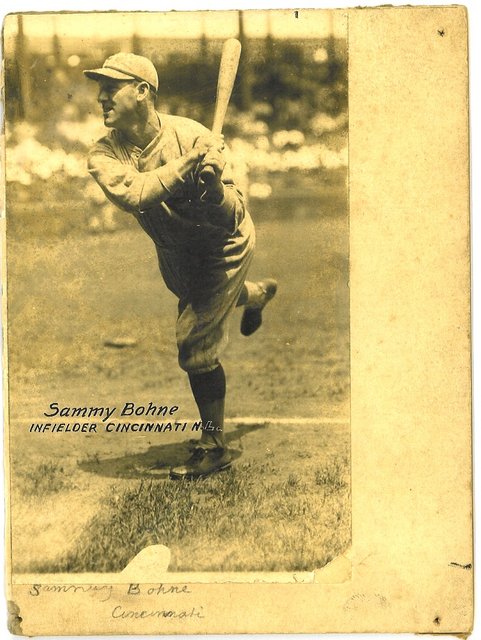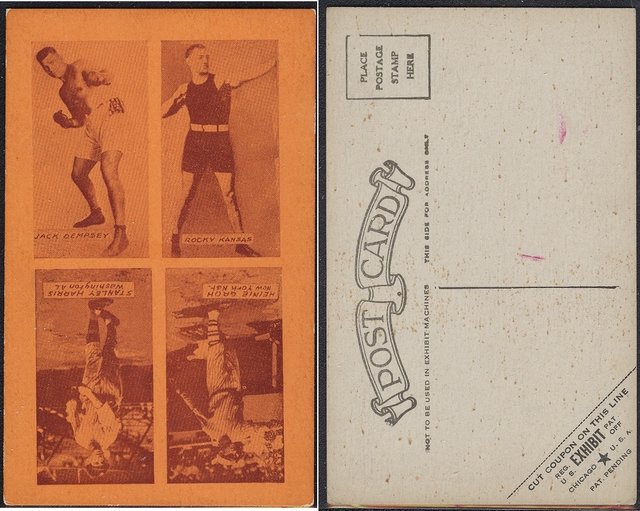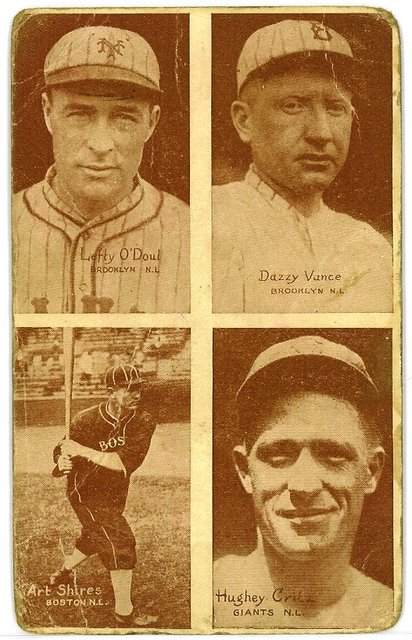The Basics Of The Set
The issue features 51 ballplayers spread over 69 different card fronts. Babe Ruth, Lou Gehrig, Rogers Hornsby, Al Simmons and Paul Waner each have 2 poses. Five cards have variations in the information on the card fronts reflecting team changes: Rogers Hornsby, Ed Rouch [sic; Edd Roush], Frank Frisch, Roger Peckinpaugh and Ty Cobb. Eight more cards exist with and without backgrounds: Urban Faber, Lou Gehrig, Charlie Hartnett, George Sisler, Tris Speaker, Phil Todt, Paul Waner, and Jimmy Wilson. Card backs are blank or with a variety of different printings (discussed below). There are also 4-on-1 cards in two formats that appear to tie into this set; they use some of the same images.
The cards have no copyrights on them nor has any advertising for them surfaced. Owing to back legends on certain cards that bar use of the cards in Exhibit machines, some commentators suggested that these cards are not ESCO products. They are incorrect. I saw a Roger Peckinpaugh from this issue with the legend on the back barring use in Exhibit machines and an ESCO corner coupon, conclusively establishing the set as an Exhibit issue.
The “father” of Exhibit card cataloguing, Elwood “Woody” Scharf, made an effort at cataloging the set that resulted in a division of the issue into three sets: Set 81, Set 82 and Set 83. This inaccurate tripartite division was an effort to account for the variations. Modern references more accurately treat the cards as one set issued in overlapping series.
Issue Dates And Short Prints
Scharf reported in 1979, without elaborating on his sources, that a black and white first printing of the set was issued in 1925. The set has been treated by other hobby authors as a 1926 or 1927 issue with updates and additions after that into perhaps 1930 or 1931. The question is of more than academic concern because there are potential rookie cards of Lefty Grove, Jimmy Foxx, Paul Waner, Chuck Klein and Lou Gehrig in the issue, depending on when it can be proven to have been issued. I think a 1925 first printing is quite likely, and I believe that the print run on the last of these cards ran into 1931, with numerous alterations of the print run in mid-stream. Consequently, the postcard-backed set is rife with short prints of varying degrees of rarity as players apparently were dropped and added into the print run.
The inclusion of Everett Scott as a Yankee presents a compelling case for an early 1925 first issue date. The Yankees sold Scott to the Senators on June 17, 1925. He was waived at the end of the season, selected off waivers by the White Sox in March 1926, waived again and selected by the Reds on July 6, 1926. He played his final game in the majors on July 27, 1926. Scott’s multiple team changes after June 1925 make it very unlikely that his card was first issued in 1926. I suspect that his card, which is very tough to find, was issued in 1925 and dropped with the first revision of the set after the 1925 season.
Three other players are likely to have been issued in 1925-1926 only. Sammy Bohne is featured in the set as a Cincinnati player. The Reds sold Bohne to the Dodgers on June 15, 1926; he never played in the majors after 1926. It is unlikely that his card was prepared after June 1926, or he would have been with the Dodgers, not the Reds, and dropped in one of the first revisions of the set. Jimmy Johnston had his last hurrah in the majors on September 11, 1926. Jack Fournier is shown with Brooklyn. He was purchased by the Boston Braves from the Brooklyn Robins on November 5, 1926. I suspect his card was dropped thereafter. Had his card been issued in 1927, I would expect that it would have been revised as were some other cards (see below). Likely replacements for Scott, Bohne, Johnston and Fournier were Paul Waner, Jimmy Foxx, Lefty Grove and Lou Gehrig. Waner came up to the majors in mid-1926. Jimmy Foxx debuted in 1925 but played only 10 games that year and a handful in 1926. Lefty Grove debuted in 1925 and was a sub-.500 pitcher for two years. Gehrig came to the Yankees in 1923 but hardly played until Wally Pipp infamously took a day off in 1925.
Ralph Pinelli, Hugh McQuillan, Walter Johnson and Johnny Bassler are moderately difficult to find and present a pretty good case as being issued from 1925-1927 then dropped; all last played in the Big Leagues in 1927.
We can also catalog certain “no earlier than” cards based on debut dates or other trades. After Tris Speaker (allegedly) conspired with Cobb to fix a game, the Indians got rid of him. Speaker played in Washington in 1927 and went to the A’s in 1928. Speaker’s card shows him in a Washington uniform listed as an Athletic. His card has to be a 1928 issue; I suspect it was a one-year card as well because Speaker played only 64 games in 1928 before retiring. Chuck Klein hit the Show on July 30, 1928. His card probably was issued in late 1928 or in 1929 to replace another card. Lefty O’Doul is shown as a member of the Phillies, to whom he was traded on October 29, 1928. His card certainly is a 1929 issue.
There are a few other cards that I would suggest are short prints. Most Babe Ruth cards I have seen offered for sale have been the batting pose. The later portrait pose thus appears to be a short print. The following cards just do not appear very often for sale; all must have been pulled after relatively short print runs: Tom Griffith, Heinie Groh, Bob Meusel, Walter Pipp, Jack Smith.
Updated Cards
The five cards with card front legend variations (Cobb, Frisch, Rouch [sic], Peckinpaugh and Hornsby) have update labels pasted on them that were created to reflect trades. They are interesting because of what they reveal about the process by which Exhibit cards were made and timing of different print runs.
Exhibit cards are half-tone prints created from black and white photos with handwritten captions and/or labels (see the Sammy Bohne original art:


).
It is not possible to paste a label on to a half-tone printing plate. In order to change those five cards, ESCO would have had to paste the labels to the original photos then shoot them again and make new printing plates.
One reason that Scharf’s Set 81-Set 82-Set 83 division never sat right with me is that it groups all five of the relabeled images into Set 82, but two of the five cards reflect moves that took place after the 1927 season. Cobb was dumped by the Tigers after the 1926 season and went to the A’s. The updated version of the card shows him with the A’s; the original has him with the Tigers. Frisch joined the Gashouse Gang on December 20, 1926 in a trade for Hornsby. His corrected card reflects the trade. Edd Roush went from the Reds to the Giants on February 9, 1927. His card reflects the trade but still misspells his name as “Ed Rouch”. Hornsby’s original card shows him with the Cardinals and the relabeled card shows him with Boston, a trade that took place after the 1927 season, not the 1926 season. Peckinpaugh’s card lists him with Cleveland, where he took over as manager for 1928. Also, the printed coupon on the back of the Peckinpaugh Cleveland card I saw indicates a 1928 issue date. I suspect that the Cobb, Rouch [sic] and Frisch cards were changed for 1927 and the Hornsby and Peckinpaugh were changed a year later. Hornsby is the easiest of the updated cards to find, even though it was likely printed for only one year (1928) because he was traded by Boston to the Cubs after a year. Cobb, Frisch and Rouch [sic] are about equally tough, but Peckinpaugh is nearly impossible, probably because his update card reflects a very short print run.
Second Poses
As noted above, 5 players have second poses in the set. Ruth, Gehrig and Waner each have batting and portrait cards, with the portrait cards all being the later issues. Hornsby’s second pose (third if you count the trade-updated card) shows him with the Cubs and is quite difficult to find, I suspect because by 1929 he was a part-time player and the card may have been pulled after a relatively short print run. Al Simmons’ second card is an oddity in that the first card, which is the short-print, shows him at the end of a batting stroke facing left, while the second card shows him head on at the end of a batting stroke. The difference is so subtle that it leaves one to wonder why the company bothered to make the new card. Differences in his uniform prove that the images are from different photo sessions.
Silhouette Cards
One more major subset of the issue remains to be discussed and placed in context. As noted in the introduction, Faber, Gehrig, Hartnett, Sisler, Speaker, Todt, Waner and Jimmy Wilson exist with images that either have or do not have backgrounds. In practical terms it appears that ESCO made cards with backgrounds intact (i.e., full photographs were used to create the plates), then cut out silhouettes of the players and the legends from the original hand-inked photos and created new printing plates for the silhouette cards. In all cases the silhouette cards are much harder to find than their full background brothers; I classify them all as short prints. I think ESCO tried to stretch their existing materials by creating the silhouette cards and adding them to the print run some time in 1928, based on Tris Speaker’s inclusion in the silhouette group. Since there are so many short printed common cards from the first printings (suggesting that they were pulled relatively early in the print run), it may be that the company added these new cards of superstars to the mix to boost sales as it retooled. ESCO generally seems to have run with images for 3-4 years before retooling, as is proven from the extensive reuse of images with in the 1921-24 and 1925-28 baseball issues; this set follows that pattern in its reuse of already-issued cards combined with new cards.
Back Variations
Many, perhaps a majority, of the collectors of this issue do not concern themselves with the card backs, which is a shame because the backs are at least as important to sorting the printings as the card fronts. The initial runs of the issue were made with blank backs or backs that had a postcard design with the words “THIS SIDE FOR CORRESPONDENCE” printed on them. Later runs substituted the phrase “NOT TO BE USED IN EXHIBIT MACHINES” for the “correspondence” legend, and still-later print runs added “MADE IN USA” to the card backs.
The back characteristics I just outlined fit with the historical evidence presented by the likely 1925-1926 cards I have collected. In every case where I have run across a card that “should” be a short-print from this issue’s earliest run, the card has been either blank-backed or had the “correspondence” legend. I would say that blank-backed and “correspondence” cards should be considered short prints, even for players who have later cards of the same pose with the more common backs. If there are blank-backed or “correspondence” cards for a particular player who has a putative “rookie” card in the set, only those cards, not later cards with the “not to be used” backs, are their actual rookie year issues. This has a great deal of importance with Gehrig. I have yet to see a blank-backed Gehrig card. I think it very likely that any Gehrig card that has a blank back is a 1925 issue, while any card with a legend on the back is a 1926 or later printing. Since Gehrig’s 1925 regular issue card is a rookie and sells for thousands of dollars, dating the Gehrig in this set is critical.
How the “not to be used” legend is printed is the key to parsing the later printings into their different years. The first of the “not to be used” legends was printed on the card backs using type that has different wear than the rest of the type on the card back, indicating that ESCO took an old plate for the backs and slapped in the new wording with newer type. On later printings the backs have uniform type faces with uniform wear, indicating that the company replaced the makeshift backs at some point with entirely new backs.
One final linguistic twist on the card backs is the “USA” legend added late in the print run. The “regular” 1928 ESCO baseball set is occasionally found with postcard backed cards; these cards have the “USA” line above the divider. I therefore assume that the “USA” legend was first added to this set around 1928-1929. The last printings of the set have a very uniform back with a legend printed in smaller sans-serif typeface, with the “USA” line on it. I am fairly certain that this back was used in 1929-31 because it is found on two rare 4-on-1 cards made from the images in this set, one of which includes Lefty O’Doul as a Brooklyn player. Lefty was traded to Brooklyn on October 14, 1930; the card could not have been made before that trade. ESCO began recycling its other 1920s baseball issues into 4 on 1 cards in 1929; not coincidentally, it appears to have done the same with these cards in 1930-31 with the 4 on 1 cards.
4 On 1 Cards
There are two distinct formats of 4-On-1 cards that use the images from this set. The first features mixed subjects drawn from the baseball issue, a related boxing issue called the Blue Boxers, and some entertainment cards. It is very rare, with only 4 1/2 known cards. I use the fraction because George Kelly and Jackie Smith cuts exist that appear to be taken from one of these cards, and two boxers from the ten-card strip set made with this art have yet to surface on the 4 on 1 mixed sport issue. Again, these are absolutely ESCO products: a card featuring boxers Jack Dempsey and Rocky Kansas with baseball players Heinie Groh and Stanley Harris captioned with the “not to be used in exhibit machines” legend and a coupon back exists.

The second of the card types has 4 known cards. It looks to me that the mixed subjects cards were drawn from the 1925-1926 printings, while the baseball-only type were created ca. 1931 based on the use of the O’Doul Brooklyn image. I have seen more of the second type of cards than the earlier ones, but all are rare; we are talking about only a handful of known specimens of each card.
There is also a significant tie-in to the W517 sets (regular and mini). The same art with the same handwritten front information is on all three sets, and some W517 subjects appear on the 4 on 1 cards (Shires, Collins and O'Doul Brooklyn), so I strongly suspect that the issuer of W517 either was ESCO or had a tight relationship with ESCO.

